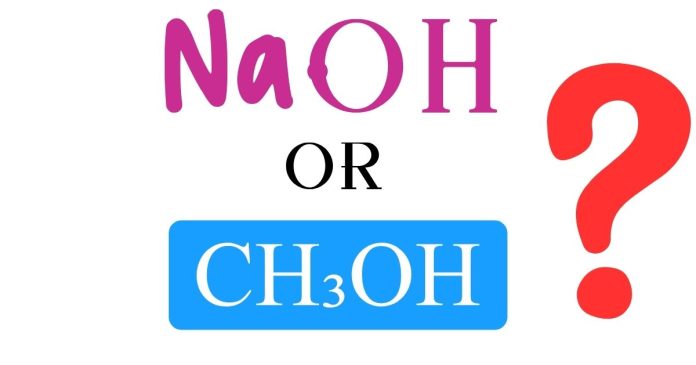When comparing the melting points of sodium hydroxide (NaOH) and methanol (CH₃OH), the difference comes down to the types of bonding and intermolecular forces present in each substance. These factors determine how much energy is required to overcome the forces holding the particles together in a solid state.
Sodium Hydroxide (NaOH)
- Type of Compound: Ionic
- Structure: Sodium hydroxide consists of ions (Na⁺ and OH⁻) arranged in a strong, rigid crystal lattice.
- Forces at Play: Ionic bonds, which are among the strongest chemical bonds, hold the lattice together. Overcoming these bonds requires a significant amount of energy.
- Melting Point: Approximately 318°C (604°F).
Methanol (CH₃OH)
- Type of Compound: Molecular
- Structure: Methanol is an organic molecule made of covalent bonds, with a hydroxyl group (-OH) that enables hydrogen bonding between molecules.
- Forces at Play: Methanol molecules are held together primarily by hydrogen bonds, which are weaker than ionic bonds. These bonds are easier to overcome compared to the ionic lattice of NaOH.
- Melting Point: Approximately -98°C (-144°F).
Why NaOH Has a Higher Melting Point
- Bonding Strength:
- NaOH is an ionic compound, and ionic bonds are much stronger than the hydrogen bonds present in methanol.
- Methanol, being a molecular compound, relies on weaker intermolecular forces (hydrogen bonding and Van der Waals forces).
- Crystal Lattice Structure:
- The ions in NaOH are tightly packed in a crystal lattice, requiring a significant amount of heat energy to disrupt the structure.
- In contrast, methanol has a simpler molecular structure, and its intermolecular forces are easier to overcome.
- Molecular Size and Polarity:
- Methanol is a smaller, polar molecule with fewer intermolecular interactions compared to the ionic network in NaOH.
Practical Implications
- Sodium Hydroxide (NaOH):
- Its high melting point makes it suitable for industrial applications where high temperatures are involved, such as in the manufacture of soap and paper.
- It is also a strong base, highly reactive with water, and requires careful handling.
- Methanol (CH₃OH):
- Its low melting point makes it a liquid at room temperature, making it useful as a solvent and a fuel in low-temperature environments.
- Its weaker bonding makes it highly flammable and volatile.
Sodium hydroxide (NaOH) has a significantly higher melting point (318°C) than methanol (CH₃OH, -98°C) due to its ionic bonding and rigid crystal lattice structure. In contrast, methanol’s melting point is much lower because of its reliance on weaker hydrogen bonds and Van der Waals forces. Understanding these differences is crucial in choosing the right compound for specific applications.
If you’d like to explore more about chemical properties or related comparisons, feel free to ask!


